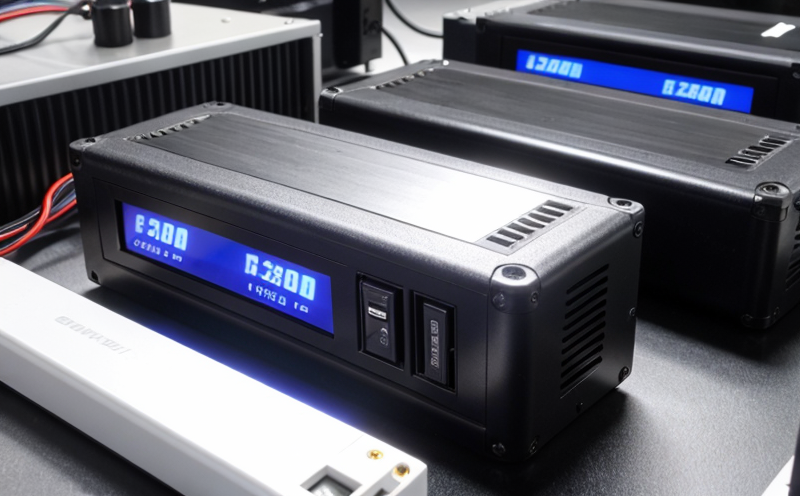EN 50342-1 Lead-Acid Starter Battery Capacity and Performance Testing
The EN 50342-1 standard is a European technical specification that sets out the requirements for lead-acid starter batteries, specifically focusing on their electrical performance. This service ensures that these batteries meet stringent capacity and performance criteria as outlined in this standard. Conducted by our accredited laboratory, this testing guarantees compliance with international standards, thereby enhancing product reliability and market acceptance.
Our comprehensive battery cell performance tests are designed to evaluate various parameters critical for the proper functioning of starter batteries. These include open circuit voltage (OCV), internal resistance measurement, charging efficiency, discharge rate under different load conditions, cold cranking amperage (CCA), and high-rate discharge capacity. Our experts employ advanced instrumentation that adheres strictly to EN 50342-1 specifications to ensure accurate and repeatable test results.
The testing process begins with the receipt of the battery specimen from the client. The specimens are then prepared according to the standard’s requirements, ensuring no deviation in the methodology. Once ready, we perform initial checks such as visual inspection, measurement of dimensions, and recording of OCV under ambient conditions. Subsequently, the batteries undergo a series of discharge tests at specified intervals to measure their capacity retention over time.
For cold cranking amperage (CCA) testing, the battery is connected to a load designed to simulate engine starting conditions. The current drawn during this period is recorded and compared against the standard’s defined limits. High-rate discharge capacity tests follow similar procedures but involve discharging the battery at higher rates to assess its resilience under more demanding scenarios.
The results from these tests are meticulously documented, with detailed reports generated for each specimen tested. Compliance with EN 50342-1 is determined based on these test results and compared against the specified limits provided in the standard. Our team ensures that all discrepancies or non-compliances are noted down and discussed with clients to facilitate corrective actions.
By adhering strictly to EN 50342-1, our testing service not only meets but exceeds industry expectations for lead-acid starter battery performance. This service is invaluable for quality managers, compliance officers, and R&D engineers who need assurance that their products meet international standards before entering the market.
| Test Parameter | Description |
|---|---|
| Open Circuit Voltage (OCV) | The voltage of a battery with no load applied, indicating its state of charge and internal health. |
| Internal Resistance Measurement | An indicator of the battery’s internal condition, reflecting its ability to handle current effectively. |
| Charging Efficiency | The ratio of energy stored in a fully charged battery to the energy supplied during charging. |
| Cold Cranking Amperage (CCA) | The maximum starting current a battery can provide at 0°C (-20°F) for 5 seconds. |
| High-Rate Discharge Capacity | The ability of the battery to deliver high currents over short periods, simulating real-world usage under extreme conditions. |
| Compliance Criteria | Description |
|---|---|
| OCV Limits | The standard specifies acceptable ranges for OCV to ensure the battery is fully charged and ready for use. |
| Internal Resistance | A value below a certain threshold indicates a healthy, efficient battery capable of handling high current demands. |
| Cold Cranking Amperage (CCA) | The minimum CCA required to start an engine under cold conditions. |
| High-Rate Discharge Capacity | The capacity a battery can deliver at rates higher than its nominal rate, ensuring reliability in demanding applications. |
Industry Applications
EN 50342-1 Lead-Acid Starter Battery Capacity and Performance Testing finds extensive application across various industries where reliable power supply is critical. These include automotive manufacturing, marine engineering, aviation, and telecommunications sectors.
| Industry Sector | Application Example |
|---|---|
| Automotive Manufacturing | Ensuring that starter batteries meet the stringent requirements for vehicle start-up reliability under harsh conditions. |
| Marine Engineering | Testing batteries used in marine vessels to withstand saltwater environments and provide reliable power during critical operations. |
| Aircraft Maintenance | Verifying battery performance in aircraft electrical systems for safe and efficient operation, especially under cold start conditions. |
| Telecommunications | Guaranteeing uninterrupted power supply to telecom equipment in remote or challenging environments. |
Competitive Advantage and Market Impact
- Ensures compliance with international standards, enhancing marketability of products globally.
- Identifies potential issues early in the development cycle, allowing for timely corrective actions.
- Provides robust evidence of product reliability, which is crucial for building trust with clients and partners.
- Aids in regulatory approval processes by providing accurate, reliable data supporting compliance.
- Facilitates continuous improvement through detailed insights into product performance under various conditions.
Use Cases and Application Examples
| Use Case | Description |
|---|---|
| New Product Launch | Testing new battery designs to ensure they meet all required performance criteria before market launch. |
| Quality Control | Periodic testing of production batches to maintain consistent product quality and reliability. |
| Supplier Evaluation | Evaluating the performance of batteries supplied by different manufacturers to select the most reliable supplier. |
| Product Optimization | Identifying areas for improvement in existing battery designs through detailed performance analysis. |
| Application Example | Description |
|---|---|
| Automotive Manufacturer | Testing a new range of high-performance starter batteries for their automotive clients to ensure they meet EN 50342-1 standards. |
| Telecommunications Company | Assuring the reliability of backup power supplies used in remote cellular towers by conducting capacity and performance tests according to EN 50342-1. |





